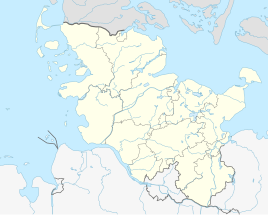Grenzland barracks (Flensburg)
|
|
|||
|---|---|---|---|

Main entrance |
|||
| country | Germany | ||
| local community | Flensburg | ||
| Coordinates : | 54 ° 48 ' N , 9 ° 24' E | ||
| Opened | 1937 | ||
| owner | Private | ||
| Stationed troops | |||
| Feldjägerbataillon 610 Telecommunications Battalion 620 Telecommunications Training Company 601 |
|
||
| Old barracks names | |||
| 1945-1953 | Hereford barracks |
|
|
| Formerly stationed units | |||
| Artillery Regiment 30th 159th Infantry Brigade 1st Battalion Herefordshire Regiment |
|
||
|
Location of the border barracks in Schleswig-Holstein |
|||
The Grenzland barracks in Flensburg ( Klues district , in the Ramsharde area ) was a barracks from 1938 to 1993 , first for the Wehrmacht and from 1956 for the Bundeswehr .
history
After the land was acquired by the city of Flensburg in February 1937, the newly built barracks was moved into on October 1, 1938 by the 1st division of the 30th Artillery Regiment under Major Paul. Shortly before, the tank barracks had also been built further south . In addition, numerous new military buildings were built at the Flensburg-Mürwik base during this time . At the beginning of World War II , a replacement battalion was relocated to the Grenzland barracks, where soldiers on leave had to report.
After the war, the barracks were administered by the British armed forces under the name Hereford Barracks and occupied by a Norwegian field artillery unit until 1953 (see Norwegian Germany Brigade ). As a result, Norwegian veterans visited the barracks annually until it was closed.
On July 16, 1956, the Bundeswehr's 13th Panzer Battalion moved into the facility. The first 80 recruits for the reintroduction of military service in the Federal Republic of Germany moved into the barracks on September 2, 1957. The buildings were renovated in 1985 and a new guard building was erected. With the withdrawal of the telecommunications battalion 620 on September 30, 1993, the military use ended.
For several years, the site lay idle or was used by the authorities, until the modern buildings had to give way to single-family homes in the late 1990s. The old buildings from the 1930s were renovated and converted into apartments. The station became a doctor's office. A street on the site was also named after the architect Paul Ziegler , who was responsible for numerous buildings that shape the cityscape of Flensburg. Among other things, he was involved in the design planning of the Mürwik Naval School and designed the German House in Flensburg together with the architect Theodor Rieve .
particularities
When the Bundeswehr was being set up in 1956, there was still no agreement on the tactical designation of the vehicles. Panzerbataillon 13 in Flensburg painted former bases of armored units of the Wehrmacht on its armored towers as a temporary solution in order to keep in touch with each other. In 2006 the Revell company brought out a 1:35 model of an M47 tank, where one of these tanks from Flensburg could be reproduced.
In the 1970s there was a sponsorship of the telecommunications battalion 620 with the special kindergarten Flensburg (at the time so called) , an institution for the care of children with disabilities.
During the snow catastrophe in Northern Germany in 1978/1979 , the barracks were located in their core area. The main task of the units stationed here was to provide remote farms with the mobile power supply devices that were available in large numbers at the 620 telecommunications battalion.
Troops
The following troops were stationed in the facility from 1936 to 1993:
Wehrmacht
- Artillery Regiment 30 (1938-1939)
- Reserve battalion
armed forces
the PzGrenBtl 161 (mot) consisted of 5 companies.
the 2nd, 3rd and 4th Kp were equipped with the good old Unimog.
The crew were 1 GrpFhr, 1 driver and 8 soldiers. The 8 soldiers sat on a so-called "double bench" in the loading area.
These "combat companies" had 4 platoons of 3 groups each. The 1st Kp was the staff and supply company with the kitchen of the Btl.
- coat of arms
-
 Radio train 755 AFNORTH ( Lw )
Radio train 755 AFNORTH ( Lw ) -
 Panzerbataillon 13 ( H )
Panzerbataillon 13 ( H ) -
 II./ Field Artillery Regiment 6 (H)
II./ Field Artillery Regiment 6 (H) -
 Panzerbataillon 16 (H)
Panzerbataillon 16 (H) -
 Panzergrenadierbataillon 161 (H)
Panzergrenadierbataillon 161 (H)
-
 Telecommunications Battalion 620 (H)
Telecommunications Battalion 620 (H) -
 Telecommunications Training Company 601 (H)
Telecommunications Training Company 601 (H) -
 Telecommunications Training Company 610 (H)
Telecommunications Training Company 610 (H) -
 Feldjägerbataillon 610 (H)
Feldjägerbataillon 610 (H) -
 Naval Telecommunications Battalion 771 ( M )
Naval Telecommunications Battalion 771 ( M )
Foreign armies
- 159 Infantry Brigade
- 4th Battalion King's Shropshire Light Infantry
- 1st Battalion Herefordshire Regiment
- 1st Battalion Cheshire Regiment (May-June 1945)
- 33 Parachute Light Regiment RA (February-September 1948)
- Norwegian 1st Infantry Battalion Tyskland Brigade (1948–1951)
- Norwegian Anti Tank Battery Tyskland Brigade (1951 - April 1953)
- Norwegian Field Artillery Tyskland Brigade (1948–1953)
Web links
- Private traditional side of the barracks
- Private traditional website on Telecommunications Battalion 620
- Tactical signs of the PzBtl. 13
- Review of the Revell M47 at Panzer-Modell.de







